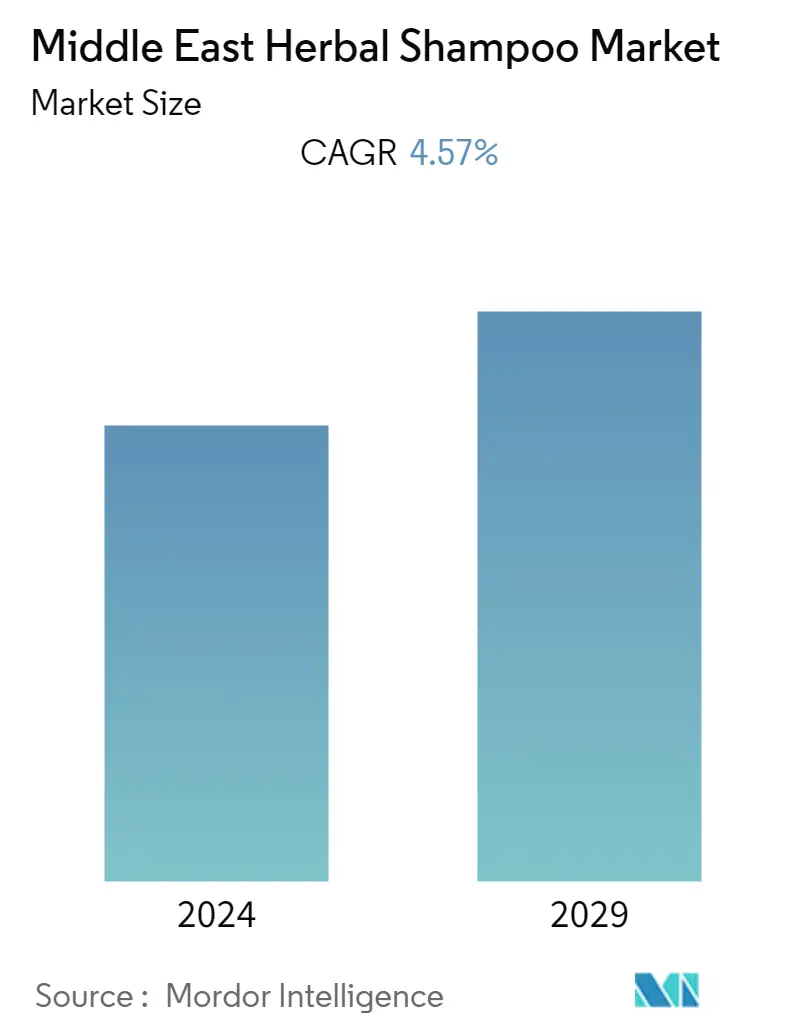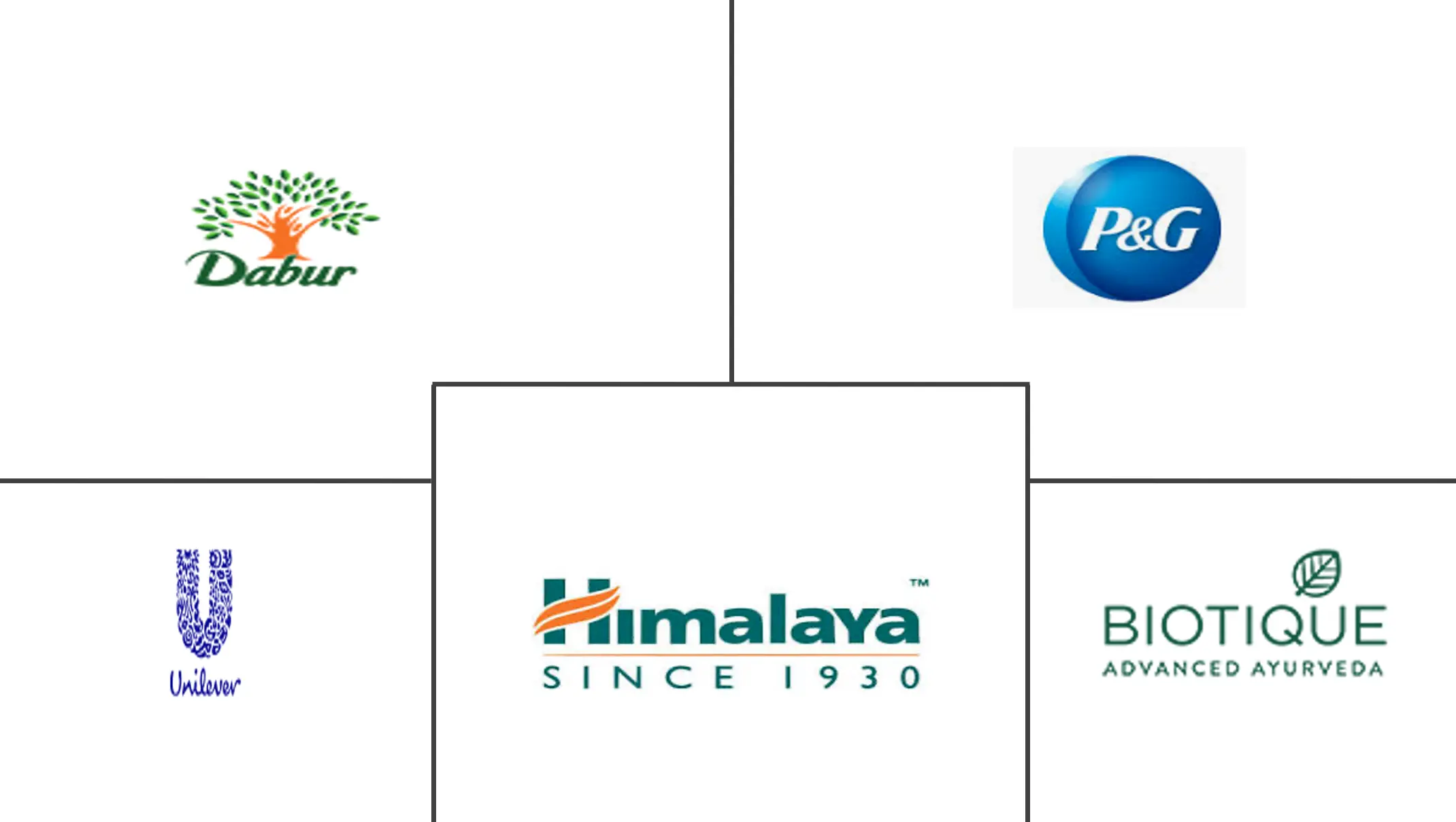Market Size of Middle East Herbal Shampoo Industry

| Study Period | 2019 - 2029 |
| Base Year For Estimation | 2023 |
| Forecast Data Period | 2024 - 2029 |
| Historical Data Period | 2019 - 2022 |
| CAGR | 4.57 % |
| Market Concentration | Low |
Major Players
*Disclaimer: Major Players sorted in no particular order |
Middle-East Herbal Shampoo Market Analysis
The Middle East herbal shampoo market is projected to witness a CAGR of 4.57% during the forecast period (2020 - 2025).
- The demand for herbal shampoo in the region is majorly boosted by increased consumer demand for sustainable, chemical-free, and eco-friendly products, along with a surge in product developments cued from contemporary market potentials. This drives manufacturers to the emerging category of Ayurveda and botanical extracts, gaining traction for its functional and earthy subtlety among consumers. Companies are even bringing premiumization in the herbal shampoo category to appeal to consumers by personalizing it to meet their needs and emphasizing its superior quality or exclusivity.
- Additionally, consumer demand for zero-waste products is growing with the increased awareness regarding climate change and the contribution of meager waste management to this devastation.
Middle-East Herbal Shampoo Industry Segmentation
The Middle East herbal shampoo market is segmented by distribution channel into supermarkets/hypermarkets, convenience stores, specialist retailers, online retailers, and other distribution channels. Based on the country, the market studied is segmented Saudi Arabia, the United Arab Emirates, Egypt, and Rest of Middle East.
| By Distribution Channel | |
| Supermarkets/Hypermarkets | |
| Convenience Stores | |
| Specialist Retailers | |
| Online Retailers | |
| Other Distribution Channels |
| By Country | |
| Saudi Arabia | |
| United Arab Emirates | |
| Egypt | |
| Rest of Middle East |
Middle East Herbal Shampoo Market Size Summary
The Middle East herbal shampoo market is experiencing a notable growth trajectory, driven by a rising consumer preference for sustainable and eco-friendly personal care products. This shift is largely attributed to increased awareness of the environmental impact of chemical-laden products, prompting consumers to seek alternatives that offer natural and organic benefits. The market is witnessing a surge in the use of Ayurvedic and botanical extracts, which are gaining popularity for their functional and earthy qualities. Manufacturers are capitalizing on this trend by introducing premium herbal shampoos that cater to personalized consumer needs, emphasizing superior quality and exclusivity. This premiumization trend, initially seen in the fashion industry, has now permeated the personal care sector, with herbal and botanical-based products becoming a primary focus.
The demand for herbal shampoos is further bolstered by the economic prosperity and high purchasing power of consumers in the Middle East, making premium products more accessible and appealing. Natural ingredients such as amla, bhringaraj, reetha, hibiscus, neem, tulsi, and shikakai are increasingly being used for their nourishing properties, offering a chemical-free alternative to traditional shampoos. The market is characterized by a consolidated structure, with major players like Dabur India Ltd, Procter & Gamble, The Himalaya Drug Company, and Unilever PLC holding significant market shares. These companies are leveraging product innovation and strategic marketing initiatives to enhance their brand image and expand their consumer base. As new global companies enter the market, the scope for expansion and product innovation remains substantial, with key players focusing on new product launches to maintain their competitive edge.
Middle East Herbal Shampoo Market Size - Table of Contents
-
1. MARKET DYNAMICS
-
1.1 Market Drivers
-
1.2 Market Restraints
-
1.3 Porter's Five Forces Analysis
-
1.3.1 Threat of New Entrants
-
1.3.2 Bargaining Power of Buyers/Consumers
-
1.3.3 Bargaining Power of Suppliers
-
1.3.4 Threat of Substitute Products
-
1.3.5 Intensity of Competitive Rivalry
-
-
-
2. MARKET SEGMENTATION
-
2.1 By Distribution Channel
-
2.1.1 Supermarkets/Hypermarkets
-
2.1.2 Convenience Stores
-
2.1.3 Specialist Retailers
-
2.1.4 Online Retailers
-
2.1.5 Other Distribution Channels
-
-
2.2 By Country
-
2.2.1 Saudi Arabia
-
2.2.2 United Arab Emirates
-
2.2.3 Egypt
-
2.2.4 Rest of Middle East
-
-
Middle East Herbal Shampoo Market Size FAQs
What is the current Middle East Herbal Shampoo Market size?
The Middle East Herbal Shampoo Market is projected to register a CAGR of 4.57% during the forecast period (2024-2029)
Who are the key players in Middle East Herbal Shampoo Market?
Dabur India Ltd., The Procter & Gamble , The Himalaya Drug Company , Unilever and Bio Veda Action Research Co. are the major companies operating in the Middle East Herbal Shampoo Market.

